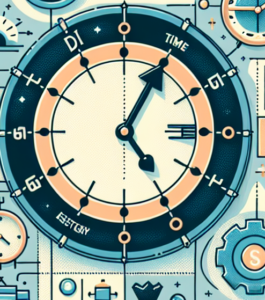As the familiar ritual of changing the clocks approaches, daylight saving time (DST) once again takes centre stage in discussions about its relevance and impact. Originating in the early 20th century, DST was introduced to make better use of daylight during the longer days of summer, ostensibly to save energy and maximize productivity. However, as society evolves, the once practical solution has become a subject of debate, with opinions divided on its benefits and drawbacks.
Daylight Saving Time Clock
While the practicality of shifting clocks back and forth is up for debate, there’s no denying that the concept of daylight saving time brings a bit of excitement. Imagine the thrill of gaining an entire extra hour in the fall and savouring the longer daylight in spring! Whether you’re an early bird cherishing those extra early morning rays or a night owl relishing more evening light, daylight saving time has a little something for everyone. Of course, there are the inevitable clock malfunctions and sleep disruptions, but that’s all part of the DST adventure! So, as the season changes, make sure to update your clocks and maybe even enjoy a moment of reflection on this quirky tradition.

A Brief History of Daylight Saving Time
The history of the daylight saving time clock is as winding and intriguing as the concept itself. It all started with the whimsical idea famously attributed to Benjamin Franklin who, in a satirical letter to the editor of the Journal of Paris in 1784, suggested that Parisians could save on candles by getting people out of bed earlier. However, the actual implementation of daylight saving time was first seriously proposed by George Hudson, a New Zealand entomologist, in 1895, who wanted more daylight hours to collect insects. It wasn’t until World War I that Germany became the first country to adopt daylight saving time in 1916, as a means to conserve energy during wartime. Other nations quickly followed suit, seeing the benefits of reducing artificial lighting to save fuel. Over the decades, the practice has evolved with varying degrees of adoption across countries and regions, reflecting a continual balancing act between perceived benefits and societal inconvenience. Even within the United States, daylight saving time has had a tumultuous history with periods of abolishment and reinstatement at different times.
But beyond the debates and controversies surrounding daylight saving time, there is something undeniably special about this biannual time change. It’s a ritual that connects us to nature, as we align our schedules with the shifting seasons. It’s an opportunity to reset our internal clocks and adjust to the changing rhythms of life. And it’s a reminder of how small changes can have big impacts in both positive and negative ways.
So as we welcome or say farewell to daylight saving time, let’s embrace this unique tradition for all its quirks and charms. Let’s revel in the extra hour of sleep or savor the extended evening sunlight. And let’s appreciate the ongoing conversation and evolution around this seemingly simple concept that has had a significant impact on our daily lives for over a century. Whether you love it or hate it, daylight saving time is here to stay, at least for now. So let’s make the most of it and enjoy the ride as we continue to save daylight one clock adjustment at a time.
And who knows what other strange traditions may emerge from seemingly innocuous ideas? Perhaps in another hundred years, people will look back and wonder how we ever survived without an annual “reset day” where we adjust all clocks to ensure perfect synchronization. Or maybe even more absurd, imagine a world where we adjust our clocks every day to maintain the illusion of time staying constant. The possibilities are endless and the conversations and debates will continue to shape our collective relationship with time.
So let’s keep an open mind as we navigate through daylight saving time and all its quirks. Because at the end of the day, it’s not just about gaining or losing an hour; it’s about embracing change and finding balance in a constantly evolving world.
Intended Benefits of DST
DST was designed to extend evening daylight, reducing the need for artificial lighting and promoting outdoor activities. It was believed to offer economic benefits by boosting retail sales and reducing energy consumption. Additionally, proponents argue that DST encourages a more active lifestyle, potentially benefiting public health.
Controversies and Challenges
Despite these intended benefits, DST has sparked considerable controversy. Critics argue that the disruption of circadian rhythms can lead to health issues such as sleep disorders, increased heart attack rates, and mental health challenges. The economic advantages are also contested, with studies showing minimal energy savings and potential productivity losses due to disrupted work schedules.
Health and Lifestyle Effects
The biannual clock change is known to impact health by disrupting sleep patterns, leading to a phenomenon known as “social jetlag.” This disruption can affect mood, cognitive function, and overall well-being. Individuals with pre-existing health conditions may find the transition particularly challenging, raising questions about the necessity of this practice.
Economic and Social Implications
Economically, the results of DST are mixed. While some sectors, like retail and tourism, might benefit from extended daylight hours, others face challenges. The agriculture industry, for instance, often opposes DST due to the disruption of natural work patterns. Additionally, the shift can affect global markets and international business operations, as time changes are not uniformly observed worldwide.
The Future of Daylight Saving Time
As society continues to evolve, the debate around Daylight Saving Time intensifies, prompting discussions about its future. Some regions have already taken steps towards abolishing the practice due to its contentious effects on health and limited economic benefits. Technological advancements, such as smart lighting and energy-efficient systems, diminish the original need to conserve energy through DST. Moreover, a growing call for consistency and increased awareness of mental health suggests that a shift towards eliminating or modifying DST might align better with modern lifestyles. As public sentiment and legislative moves evolve, the future of Daylight Saving Time remains uncertain, yet it continues to be a topic of lively discussion among policymakers and the public. Overall, the practice of DST holds a complex role in society, with its perceived benefits and drawbacks sparking ongoing debates about its necessity and potential impacts. As we continue to navigate the changing world around us, it’s crucial to consider all aspects of Daylight Saving Time and how it may affect individuals, communities, and economies. Perhaps one day, we will find a balance between saving time and preserving our well-being. Only time will tell.

As you can see, there is much more to Daylight Saving Time than just an hour lost or gained. It has far-reaching implications that extend beyond springing forward or falling back on our clocks. Whether you love it or loathe it, DST remains a fascinating topic that sparks lively debates and encourages us to question the role of time in our lives. So next time you find yourself groggy after losing an hour of sleep or enjoying the extra daylight in the evenings, remember that Daylight Saving Time is not just a practice but a concept deeply intertwined with our society and culture. And who knows – maybe one day we will find a better way to save time without disrupting our internal clocks and routines. Until then, let’s continue to embrace the changing times (literally) and make the most out of each day, whether it’s longer or shorter due to Daylight Saving Time. After all, as they say, time is precious – so let’s not waste it arguing about whether or not we should adjust our clocks twice a year. Instead, let’s use that time to appreciate the present moment and all the possibilities it holds. So here’s to embracing change and making the most out of every hour, regardless of what time may say on our clocks. Happy Daylight Saving Time! #EmbraceTheChange #MakeEveryHourCount #DSTDebatesNeverEnd

Some people may argue that changing the clock is just a minor inconvenience, but for others, it can have a significant impact on their daily routines and schedules.
For those interested in exploring the history and impact of DST further, visit this article.
For more on the latest buzz and current affairs, don’t forget to check out FitBizHouse’s Current Affairs section. Whether you’re catching up on the newest trends or diving deep into pressing topics, there’s always something engaging waiting for you. Happy reading!


